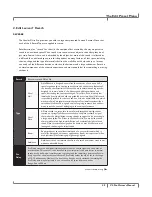
46
VL.Pro.Owner’s.Manual
Table Continued Next Page
Mid
RT
Controls the amount of time the reverb can be heard. Higher settings increase
reverberation times which are usually associated with larger acoustical environments, but
can decrease intelligibility. Lower settings shorten reverb times and should be used when
a smaller apparent space or a more subtle effect is desired.
This parameter is not available when the Ambience Type is selected.
Vocal Hall Range: 670ms to 3.387 s
Vocal Plate Range: 469ms to 4.621 s
Room Range: 73ms to 2.090 s
Size
Size sets the build-up rate of diffusion after the initial period (which is controlled
by Diffusion). The Size control changes reverb sound from very large to very small.
Generally, set this control to the approximate size of the acoustic space being created
before adjusting anything else. The Size in meters is roughly equal to the longest dimen-
sion of the space. Note that audio is temporarily muted when Size is changed.
This parameter is not available when the Room Type is selected.
Vocal Hall Range: 8m to 20m
Vocal Plate Range: 8m to 20m
Ambience Range: 4m to 16m
Shape
In the Vocal Hall reverb, Shape and Spread work together to control the overall
ambience of the reverberation. Shape determines the contour of the reverberation enve-
lope. With Shape all the way down, reverberation builds explosively, and decays quickly.
As Shape is advanced, reverberation builds up more slowly and sustains for the time set
by Spread. With Shape in the middle, the build-up and sustain of the reverberation enve-
lope emulates a large concert hall (assuming that Spread is at least halfway up, and that
Size is 30 meters or larger). Range: 1 to 64
Spread
In Vocal Hall reverb, Spread and Shape work together to control the overall
ambience of the reverberation. As Shape is advanced, reverberation builds up more
slowly and sustains for the time set by Spread. Low Spread settings result in a rapid onset
of reverberation at the beginning of the envelope, with little or no sustain. Higher settings
spread out both the buildup and sustain. Range: 1 to 99
RT
High
Cut
RT High Cut sets the frequency above which a 6dB/octave low-pass filter attenuates
the reverberated signal. It does not attenuate the reflections. High frequencies are often
rolled off with this parameter, resulting in more natural-sounding reverberation. Setting
a low frequency for this parameter can actually shorten the reverb time, as it damps the
audio as it recirculates. Range: 1.0 KHz to 20.0 KHz
High
Cut
High Cut is a second 6dB/octave low-pass filter that attenuates the entire reverberated
signal, including the reverb reflections. The typical application of this parameter sets its
frequency at approximately twice the frequency of the RT High Cut (ex. RT High Cut
6.3KHz and High Cut 12.5KHz). Range: 1.0 KHz to 20.0 KHz
Bass
Boost
Freq
Sets the frequency at which the transition from Mid Rt to Low Rt takes place. This con-
trol should be set at least two octaves higher than the low frequency you want to boost.
For example, to boost a signal at 100Hz, set Bass Boost Frequency to 400Hz. (This set-
ting works well for classical music.) Crossover works best around 400Hz for boosting
low frequencies, and around 1.5 kHz for cutting low frequencies. This parameter is not
available when the Room or Ambience type is selected. Range: 100Hz to 2.0 KHz
Bass
Boost
Bass Boost boosts or cuts frequencies below Crossover. The amount of boost or cut
required is highly dependent on the material being processed. This parameter is not
available when the Room or Ambience type is selected. Range: 0.2X to 4.0X
Edit Lexicon® Reverb Table (Continued)
The.Edit.Preset.Menu
















































